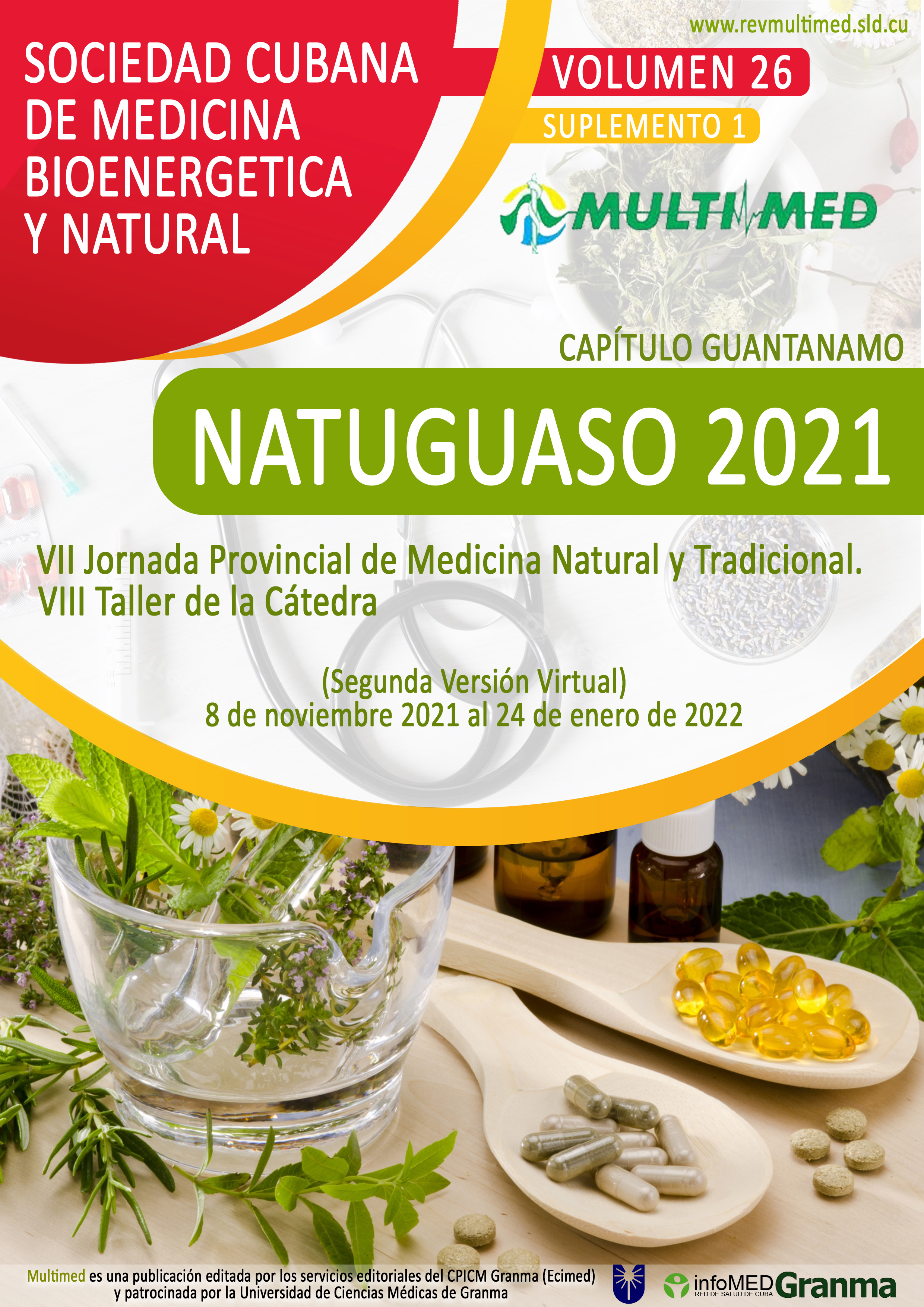Stability of a Staphylococcus aureus lysate to be used as immunomodulator
Abstract
Introduction: The problem created by the increase in Staphylococcus aureus infections and antibiotic resistance has prompted the search for new treatment variants for their control. The so-called training of the immune system with bacterial products constitutes a possibility in this sense. This fact demands the need for stable standardized products, to guarantee their immunogenicity, reproducibility, and clinical response.
Objective: To determine the stability under real conditions of a Staphylococcus aureus lysate extract.
Methods: An analytical study was carried out to determine the stability under real conditions to an extract of Staphylococcus aureus lysate, at the Center of Immunology and Biological Products of the University of Medical Sciences Camagüey, during the year 2024. In the elaboration of the extract, reference strain was used and brain heart agar was used as culture medium. To determine the stability, pH, organoleptic characteristics, sterility and volume were evaluated. The extract was conserved between 2 and 8 ºC. Regression analysis was performed with GraphPad PRISM v8.1.
Results: In the pH test, there were no changes in the first batch. In batches two and three, the changes were minimal. No significant variation trends were found in this parameter over time. The organoleptic characteristics, sterility, and volume tests showed no changes during the 12 months of the study.
Conclusions: The Staphylococcus aureus lysate shows constant stability in the tests applied during use in real conditions, so the shelf life for the product is considered optimal for 12 months. An important aspect for the pharmaceutical development of the product, and its possible clinical use.
Downloads
References
1. Bertrand B, Morales-Martínez A, Hernández-Adame PL, Muñoz-Garay C. Multirresistencia a antibióticos y alternativas para resolver esta crisis. Rev Dig Univ [Internet]. 2023 [citado 24 febrero 2025]; 2(3): 1.10. Disponible en: https://www.revista.unam.mx/wp-content/uploads/v24_n3_a1.pdf
2. Estrada-Cherres JP, Ulloa-Castro AF, Donoso-Tobar WE. Origen Hospitalario de Cepas de Staphylococcus Aureus Resistentes a Meticilina. Dom. Cien [Internet]. 2022; [citado 24 febrero 2025]; 8(2):1519-29.Disponible en: http://dx.doi.org/10.23857/dc.v8i2.2721
3. Ferrer-Bergua LG, Borrull-Senra AM, Pérez-Velasco C, Montero-Valladares C, Collazo-Vallduriola I, Moya Villanueva S, et al. Rate of methicillin-resistant Staphylococcus aureus in pediatric emergency departments in Spain. An Pediatr [Internet]. 2022 [citado 24 febrero 2025]; 97(2):95-102. Disponible en https://10.1016/j.anpede.2021.07.002.
4. Reyes-Galarza IV, Banegas-Palacio AS, Arreaga-Moran A, Coello-Vera AM, Plúas-Vera AA, Pin-Ponce RM, et al. Revisión bibliográfica: infección del sitio quirúrgico. Braz J Hea Rev [internet]. 2023 [citado 24 febrero 2025]; 6(1): [aprox. 12p.]1806-17. Disponible en: https://ojs.brazilianjournals.com.br/ojs/index.php/BJHR/article/view/56676/41576
5. Stagnaro JP, Lisarrague S, Bernstein JC, Schell C, Fortunato E, Santolin C, et al. Características clínicas y microbiológicas de infecciones de piel y partes blandas en pacientes pediátricos de dos hospitales de Buenos Aires. Actual Sida Infectol [internet]. 2022 [citado 24 febrero 2025]; 30(108): [aprox. 10 p]. Disponible en: https://revista.infectologia.info/index.php/revista/article/view/109/156
6. González-Hernández RM, Romero Martínez V, Hernández Nariño A, Morales Pérez M. Susceptibilidad antibacteriana in vitro de Staphylococcus aureus frente a extractos etanólicos de Rosmarinus officinalis y Menta arvensis cultivadas en Cuba. Revista Cubana de Plantas Medicinales [Internet]. 2023[citado 24 febrero 2025]; 28(2):e1433. Disponible en: https://revplantasmedicinales.sld.cu/index.php/pla/article/download/1433/520
7. Castrillón JD, Machado JE, Gómez S, Gómez M, Remolina N, Ríos JJ. Etiología y perfil de resistencia antimicrobiana en pacientes con infección urinaria. Infectio [Internet]. 2019[citado 24 febrero 2025]; 23(1):45-51. Disponible en: https://doi.org/10.22354/in.v23i1.755
8. González-Romero AC, Cuenca Arteaga MA, Cruz Tenempaguay RA, Araujo Baptista LM. Patrones de susceptibilidad de uropatógenos aislados de pacientes con infección en el Hospital General Docente Ambato. Rev Cub Investig Biomed [Internet]. 2024[citado 24 febrero 2025]; 43:e2199.Disponible en: https://revibiomedica.sld.cu/index.php/ibi/article/download/2199/1556
9. Jawetz E, Melnick JL, Adelbert EA. El mundo microbiano. 9na ed. La Habana: Pueblo y Educación; 1985.
10. Latorre-Barragán F, Guzmán-Chango MJ. Resistencia del staphylococcus aureus a la meticilina. Revista Cubana de Investigaciones Biomédicas [Internet]. 2023[citado 24 febrero 2025]; 42(e2908): Aprox.20p. Disponible en: https://revibiomedica.sld.cu/index.php/ibi/article/download/2908/1279
11. Lebeaux, D.; Ghigo, J. M. Beloin, C. Biofilm-related infections: bridging the gap between clinical management and fundamental aspects of recalcitrance toward antibiotics. Microbiol. Mol. Biol. Rev [Internet]. 2014[citado 24 febrero 2025]. 78(3):510-43, https://www.ncbi.nlm.nih.gov/pmc/articles/PMC4187679/
12. Ranjbar, R., Alam, M. Antimicrobial Resistance Collaborators. Global burden of bacterial antimicrobial resistance in 2019: a systematic analysis. Evidence Based Nursing [Internet]. 2022 [citado 24 febrero 2025]; 27(1), 16-16.Disponible en: https://ebn.bmj.com/content/27/1/16.abstract
13. Simon S, Labandera M. Resistencia antimicrobiana, una pandemia silenciosa. Salud Mil [Internet]. 2023 [citado 24 febrero 2025]; 42(1):1-8. Disponible en: https://revistasaludmilitar.uy/ojs/index.php/Rsm/article/view/394/846
14. Alban-Pinzón J. Resistencia a los antibióticos: Estrategias para combatir y prevenir la resistencia bacteriana. Revista Social Fronteriza [Internet]. 2024[citado 24 febrero 2025]; 4(4): e334. Disponible en: http://www.revistasocialfronteriza.com/ojs/index.php/rev/article/download/334/598
15. Dehnhardt-Walter L. Vaccine production at the ancient Bacteriological Institute of Chile. Rev. chil. Infectol [Internet]. 2022[citado 24 febrero 2025]; 39(5): 659-666. Disponible en: http://www.scielo.cl/scielo.php?script=sci_arttext&pid=S0716-10182022000500659&lng=es. http://dx.doi.org/10.4067/S0716-10182022000500659.
16. Ochando J, Mulder WJM, Madsen JC, Netea MG, Duivenvoorden R. Trained immunity — basic concepts and contributions to immunopathology. Nat Rev Nephrol [Internet]. 2023[citado 24 febrero 2025]; 19(1): 23-37. https://www.ncbi.nlm.nih.gov/pmc/articles/PMC9575643/
17. Ferreira AV, Domínguez-Andrés J, Merlo Pich LM, Joosten LA, Netea MG. Metabolic Regulation in the Induction of Trained Immunity. Semin Immunopathol [Internet]. 2024[citado 24 febrero 2025]; 46(7):1-14. https://link.springer.com/content/pdf/10.1007/s00281-024-01015-8.pdf
18. Martínez-Villarreal A, Múnera M. La inmunidad entrenada y su papel prometedor en la inmunoterapia del cáncer. Archivos de Alergia e Inmunología Clínica [Internet]. 2022[citado 24 febrero 2025]; 53(3):88-92. Disponible en: http://adm.meducatium.com.ar/contenido/articulos/30700880092_2347/pdf/30700880092.pdf
19. Covián C, Fernández-Fierro A, Retamal-Díaz A, Díaz FE, Vasquez AE, Lay MK, et al. BCG-Induced Cross-Protection and Development of Trained Immunity: Implication for Vaccine Design. Front Immunol [Internet]. 2019 [citado 24 febrero 2025]; 10: 1-14. https://www.frontiersin.org/articles/10.3389/fimmu.2019.02806/pdf
20. Salleras L. Tecnologías de producción de vacunas (II). Vacunas inactivadas. Vacunas [Internet]. 2002 [citado 24 febrero 2025]; 3(2):78-84. Disponible en: https://www.sciencedirect.com/sdfe/pdf/download/eid/1-s2.0-S1576988702702835/first-page-pdf
21. Centro para el Control Estatal de los Medicamentos (CECMED). Regulación M 116- 23. Requisitos para los estudios de estabilidad de productos farmacéuticos terminados nuevos y conocidos [Internet]. La Habana, Cuba (Documento regulatorio). 2023 [citado 24 febrero 2025]. Disponible en: https://www.cecmed.cu/file/11864/download?token=3QUGa9YS
22. Centro para el Control Estatal de los Medicamentos (CECMED). Regulación No. 25-2000. Requerimientos de los estudios de estabilidad para el registro de productos biológicos y biotecnológicos. La Habana, Cuba (Documento regulatorio). 2004. [citado 24 febrero 2025] Disponible en: https://www.cecmed.cu/sites/default/files/adjuntos/Reglamentacion/Reg_25-00.pdf
23. Lafarga-Lapieza, V; Meroño-Saura, M A; Colastra-Ugena, E; Portela-Sotelo, A; Díaz-Barreda, M D; Barreda-Hernández, D. Estabilidad fisicoquímica y microbiológica de un colirio de insulina 10 UI/mL. O.F.I.L [Internet]. 2024[citado 24 febrero 2025]; 34(1): 73-77. Disponible en: https://pesquisa.bvsalud.org/portal/resource/pt/ibc-232626
24. Hernández A, Murillo-Cisneros LM, Parra-Cervantes P, Soto-Vázquez R, Herrera-Márquez AX. Desarrollo de vacunas contra el SARS-COV-2: relaciones entre regulación sanitaria y la propiedad intelectual. Revista Ciencia, Tecnología e Innovación [Internet]. 2022[citado 24 febrero 2025]; 20(26): 45-88. Disponible en: https://doi.org/10.56469/rcti.vol20n26.706
25. Criado MT, Sánchez S, Ferreirós CM. Vacunología clásica y nuevas tecnologías en el diseño de vacunas. Enferm Infecc Microbiol Clin [Internet]. 2008[citado 24 febrero 2025]; 26(9):564-72. Disponible en: https://www.researchgate.net/profile/SandraSanchez34/publication/247075290_Vacunologia_clasica_y_nuevas_tecnologias_en_el_diseno_de_vacunas/links/5f2159cf299bf134048f86d0/Vacunologia-clasica-y-nuevas-tecnologias-en-el-diseno-de-vacunas.pdf
26. Machado M, Mahy T, Pérez E, Noroña M, Fajardo EM, Izquierdo L. Estudios de estabilidad de vida de estante en condiciones de estrés de la vacuna antileptospirósica vax-SPIRAL®. Vaccimonitor [Internet]. 2007 [citado 24 febrero 2025]; 16(1): 1-5. Disponible en: http://scielo.sld.cu/scielo.php?script=sci_arttext&pid=S1025028X2007000100001&lng=es.
27. Quesada-Leyva L, Quintana-Verdecia E, Nicolau-Pestana E, Fuentes-Diaz Z, Hernández-Rodríguez M, Castro-Consuegra M. Estabilidad del Plasma Rico en Plaquetas autológo mediante la simulación de transporte. Hematología 2023 [Internet]. 2023[citado 24 febrero 2025]; Disponible en: https://eventoshematologia.sld.cu/index.php/hematologia23/2023/paper/viewFile/140/59
28. Landys-Chovel M. Métodos alternativos como parte de las nuevas tendencias en el control de calidad de vacunas. VacciMonitor [Internet]. 2018[citado 24 febrero 2025]; 27(3):110-118. Disponible en: http://scielo.sld.cu/pdf/vac/v27n3/vac05318.pdf
29. Yáñez-Chamizo B, Yanelis-Martínez P, González-Cabeza Y, Figueroa-Pérez R, Pérez-Gutiérrez J, Hechavarría-Miláet JA, et al. Centro para el Control Estatal de Medicamentos, Equipos y Dispositivos Médicos (CECMED) Administración de Riesgo a la Calidad. Su enfoque regulador en las Buenas Prácticas de Fabricación [Internet]. La Habana: CECMED; 2017 [citado 24 febrero 2025]. Disponible en: https://www.cecmed.cu/sites/default/files/adjuntos/DocsLicencias/bpfarmaceuticas_0.pdf
30. Fernández G.A., Núñez, J.J. Creación de capacidades y desarrollo local: el papel de los Centros Universitarios Municipales. 2020. La Habana: Editorial Universitaria Félix Varela.
31. Muguercia-Montes de Oca F, Martínez-Tena A, Expósito García E. Los estudios de desarrollo local en Cuba. Recorridos espaciales y temporales. Estudios del Desarrollo Social: Cuba y América Latina [Internet]. 2023[citado 24 febrero 2025]; 11(3): 235-246. Disponible en: https://revistas.uh.cu/revflacso/article/download/7458/6353
32. Díaz-Canel-Bermúdez M, Fernández-González A. Gestión de gobierno, educación superior, ciencia, innovación y desarrollo local. Retos de la Dirección [Internet]. 2020[citado 24 febrero 2025]; 14(2): 5-32. Disponible en: http://scielo.sld.cu/scielo.php?script=sci_arttext&pid=S2306-91552020000200005&lng=es&tlng=es
33. Ruiz-Toledo, N. La dirección de los procesos de desarrollo local del deporte desde un enfoque de ciencia. Márgenes. Revista multitemática de desarrollo local y sostenibilidad [Internet]. 2024[citado 24 febrero 2025]; 12(1), 165-179. Disponible en: https://revistas.uniss.edu.cu/index.php/margenes/article/view/1789/version/1826
34. Díaz-Canel Bermúdez MM, Delgado-Fernández M. Modelo de gestión del gobierno orientado a la innovación. Revista Cubana de Administración Pública y Empresarial [Internet]. 2020[citado 24 febrero 2025]; 4(3) 300-321. Disponible en: https://apye.esceg.cu/index.php/apye/article/view/141/97
35. Paez-González Y, Gutiérrez-Segura M, Niño Peña A, Perodín Leyva Y, Tamayo Avila Y, Romero Junquera CR. Nivel de conocimiento en estudiantes sobre lesiones traumáticas con la utilización de un software educativo Correo Científico Médico (CCM) [Internet]. 2025[citado 24 febrero 2025]; 29: [aprox. 14 p].Disponible en: https://revcocmed.sld.cu/index.php/cocmed/article/download/5207/2630
36. Hernández-Navarro EV, Negrete-Gordón KF. El desarrollo sostenible en la Educación Superior de la disciplina Embriología MEDICIENCIAS UTA [Internet]. 2025[citado 24 febrero 2025]; 9 (1):77-86. Disponible en: https://revistas.uta.edu.ec/erevista/index.php/medi/article/download/2721/3148
Published
How to Cite
Issue
Section
License
Copyright (c) 2025 Edilberto Machado del Risco, Alexis Labrada Rosado, Cira Cecilia León Ramentol, Elisabet Nicolau Pestana

This work is licensed under a Creative Commons Attribution-NonCommercial 4.0 International License.
Copyright: Camagüey Medical Archive Magazine, offers immediately after being indexed in the SciELO Project; Open access to the full text of the articles under the principle of making available and free the research to promote the exchange of global knowledge and contribute to a greater extension, publication, evaluation and extensive use of the articles that can be used without purpose As long as reference is made to the primary source.
Conflicts of interest: authors must declare in a mandatory manner the presence or not of conflicts of interest in relation to the investigation presented.
(Download Statement of potential conflicts of interest)
The Revista Archivo Médico de Camagüey is under a License Creative Commons Attribution-Noncommercial-No Derivative Works 4.0 International (CC BY 4.0).
This license allows others to distribute, to mix, to adjust and to build from its work, even for commercial purposes, as long as it is recognized the authorship of the original creation. This is the most helpful license offered. Recommended for maximum dissemination and use of licensed materials. The full license can be found at: https://creativecommons.org/licenses/













 22 julio 2025
22 julio 2025